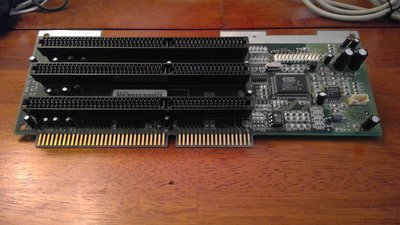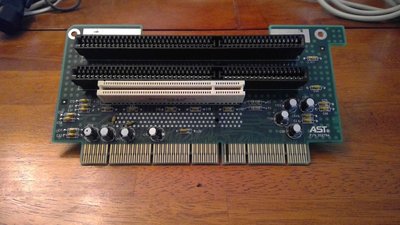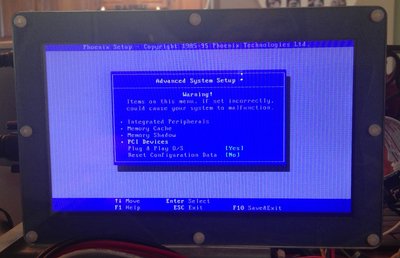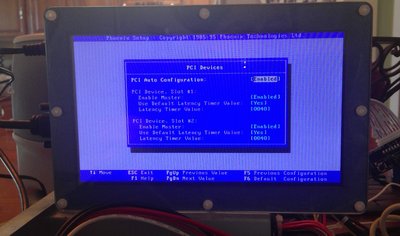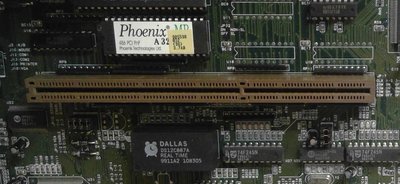Hello, sorry to resurrect this old topic, but I have the same system (an AST Advantage! Adventure 4100, more on that later) and am looking into doing something similar. I've been coming back to this topic quite a bit; the pictures have been a great way to check on things without opening up my case!
I've been doing a lot of research into this PC to try to figure out jumper settings. I was originally only able to find them for an old verision of this motherboard, the 1.1 revision:
https://stason.org/TULARC/pc/motherboards/E/E … 10-8810A-V.html
Many of the jumper settings in the above link clearly match up to the jumper settings printed on your and my 1.3 revision motherboards, but with different jumper lablels, and are mostly straightforward but the CPU selection jumpers are much less clear. Here is a picture of the 1.2 revision board, which I don't know of the jumper settings for, but the 1.1 settings above should be more useful for anyone with this board:

Note the different cluster of jumpers next to the CPU, which very roughly correspond to jumpers 19-29 on the 1.3 board.
I was looking at different models of PCs to try to find others with the same motherboard as this one. Since yours is a 575+ and mine is a 4100, I wanted to check if the bioses were the same. Checking the bios update disks whose filenames can be found here http://filedump.glitchwrks.com/mirrors/AST/S-BIOS/bios.txt, for the 575p/575+ (your model, named "twister.bio" in the floppy image) and the 4100 (my model, named "rockyii.bio") are the exact same binary image. So I think it can be concluded that the AST Advantage! Adventure 4100 and the Advantage! Adventure 575 are essentially the same computer with different configurations/marketing. (but, perhaps the bios detects this somehow and changes behavior...)
(One other thing I noticed was that patch cable that is on your motherboard is not present on mine. The patch cable seems to end up near the video circuitry, maybe its related to some fuzziness in my VGA output...? I'm considering adding one of these to my board to test this theory)
I also noticed in a hex editor, the bios contains a text string about "Epson 7000". As I'm now learning, Epson ventured into making PCs, and they used this motherboard in a few of the PCs they made. What's more, some seemed to use the exact same case as used for the AST models. Looking for manuals for Epson computers, I was finally able to find one that corresponded to this exact motherboard, including the missing jumper settings*!
Now I can be sure my Pentium Overdrive is configured the right way with the CPU jumper settings 😀 I hope that if you still have this computer, this information will also be helpful to you! (and anyone else googling this) This is the Epson ActionTower 7000/8400, and its spec sheet/short form manual is still available on Epson's website. It has the 1.3 revision motherboard:
https://files.support.epson.com/pdf/apc73_/apc73_pg.pdf
*NOTE: for additional jumper settings not covered in apc73_pg.pdf, see this, "Addendum: Jumper Settings (4100, 575+, and 575)". This is an update bulletin released by AST, and it gives you jumper settings, for Am486DX4 100, and Am5x86 133Mhz: https://web.archive.org/web/19970720031930/ht … ur/3605_001.pdf
Here's a full user's manual which includes the Epson 8400 model, and seems to correspond to this motherboard. I didn't see the CPU jumper settings searching through though, but that's fine, they're in the above two documents. It seems there may be a number of other Epson models using this motherboard. https://files.support.epson.com/pdf/at8k__/at8k__u1.pdf
Also, huge thanks to Epson for keeping these documents online for a 25 year old product category they don't sell anymore! If only all companies did this...
Other models which seem to have the 1.1/1.2 revision of this motherboard using the older jumper settings are the ActionTower 7500 and the Endeavor 486i, as well as earlier versions of the ActionTower 7000/8400, which I also found manuals for. Also of note was this 196 page full users manual for the ActionTower 7500, although it includes the old jumper settings and motherboard layout: https://files.support.epson.com/pdf/at7500/at7500u1.pdf
==============
Now, back to the original topic at hand! I myself have wanted to put a PCI 3d card in this computer. If you look at the first, shorter manual I posted for the ActionTower 7000/8400, it tells you the pinouts for the PCI riser card. The manual even makes reference to a "PCI riser option card". I wasn't able to find any more information about this, but this at least confirms that there should be a card floating around out there that the motherboard (but perhaps not the bios) supports. The manual suggests that it supports 2x PCI and 3x ISA.
Here's a picture the original riser card to show how deep it goes in the slot. The slot itself is about 1.25cm deep total.

Here's the slot from above.

Temporary clock hackjob, please ignore
Some are hard to see, but it has the grooves that line up to the card the OP was trying to use, and opening my case up and counting manually, the pinout appears the same.
I'll be trying to figure this out myself in the next few weeks in terms of finding a working ISA/PCI riser card for this PC so I'll update with any results!
==============
One more very interesting note about this PC: In the manuals for the Epson models, it says you can set this computer into an 8MHz "slow mode" using ctrl + alt + minus and back to normal speed with ctrl+alt+plus. This seems like it would be very cool for ancient software compatibility. I also noticed a turbo switch header (but with no pins), I will probably test that out as well. The manual says "Fast and slow processor speeds available; fast is the speed of the processor and slow is 8 MHz; from the MS-DOS prompt, speed selectable by pressin Ctrl Alt - (slow) or Ctrl Alt + (fast)
I can't actually test this just yet but will see if it works on this model, which brings us to...
ONE MORE very interesting note: I tried using one of those bios flashing disks and copied the bios to the hdd first but it froze at "Waiting..." for quite some time, until I eventually restarted my computer (despite its instructions not to). Well now there's no video and it won't POST, so I have an EEPROM programmer in the mail to recover from that. So I suppose I can't recommend using one of those disks to flash your BIOS (i did copy it to C first but oh well). My bios was from august 1996, the update is from october 1996 and the only changelog information is "ENHANCEMENTS: A Plug-and-Play ID was modified from 81177406 to 1197406. "
Some more digging shows that the AST Adventure 466 uses a bios version "3.6" (the only bios from AST close to 3.7ab) and uses the same hard disk restore disk as the 4100. My guess is that the 466 uses the revision 1.1 or 1.2 motherboard.
==============
Some other stuff:
AST Adventure! User Manual, listed on the AST web site as for the 5166. It seems to mostly correspond to the 4100/575+, but the motherboard picture at the end looks completely different from revs UP8810A 1.1, 1.2 or 1.3. It also doesn't seem to have any CPU jumper settings.
https://web.archive.org/web/19970720031849/ht … ur/3634_001.pdf
By the way, here's a list of AST files and drivers which are not archived, but can be found around the internet
https://web.archive.org/web/19970719190034/ht … pport/files.htm
And it looks like you can find most if not all of that here, obligatory warning about it not being on an official AST site; use at your own risk:
http://filedump.glitchwrks.com/mirrors/AST/
Latest AST BIOS tables:
https://web.archive.org/web/19970719190151/ht … rt/biostbls.htm
575plus video fixup diskette technical bulletin (apparently it adds a couple lines to autoexec.bat)
https://web.archive.org/web/19970720013927/ht … /SBS/0356sb.htm
